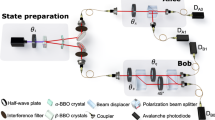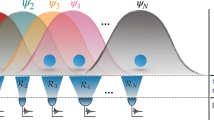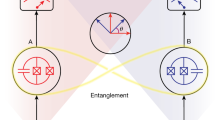Abstract
More than 50 years ago1, John Bell proved that no theory of nature that obeys locality and realism2 can reproduce all the predictions of quantum theory: in any local-realist theory, the correlations between outcomes of measurements on distant particles satisfy an inequality that can be violated if the particles are entangled. Numerous Bell inequality tests have been reported3,4,5,6,7,8,9,10,11,12,13; however, all experiments reported so far required additional assumptions to obtain a contradiction with local realism, resulting in ‘loopholes’13,14,15,16. Here we report a Bell experiment that is free of any such additional assumption and thus directly tests the principles underlying Bell’s inequality. We use an event-ready scheme17,18,19 that enables the generation of robust entanglement between distant electron spins (estimated state fidelity of 0.92 ± 0.03). Efficient spin read-out avoids the fair-sampling assumption (detection loophole14,15), while the use of fast random-basis selection and spin read-out combined with a spatial separation of 1.3 kilometres ensure the required locality conditions13. We performed 245 trials that tested the CHSH–Bell inequality20 S ≤ 2 and found S = 2.42 ± 0.20 (where S quantifies the correlation between measurement outcomes). A null-hypothesis test yields a probability of at most P = 0.039 that a local-realist model for space-like separated sites could produce data with a violation at least as large as we observe, even when allowing for memory16,21 in the devices. Our data hence imply statistically significant rejection of the local-realist null hypothesis. This conclusion may be further consolidated in future experiments; for instance, reaching a value of P = 0.001 would require approximately 700 trials for an observed S = 2.4. With improvements, our experiment could be used for testing less-conventional theories, and for implementing device-independent quantum-secure communication22 and randomness certification23,24.
This is a preview of subscription content, access via your institution
Access options
Subscribe to this journal
Receive 51 print issues and online access
$199.00 per year
only $3.90 per issue
Buy this article
- Purchase on Springer Link
- Instant access to full article PDF
Prices may be subject to local taxes which are calculated during checkout




Similar content being viewed by others
References
Bell, J. S. On the Einstein–Podolsky–Rosen paradox. Physics 1, 195–200 (1964)
Einstein, A., Podolsky, B. & Rosen, N. Can quantum-mechanical description of physical reality be considered complete? Phys. Rev. 47, 777–780 (1935)
Freedman, S. J. & Clauser, J. F. Experimental test of local hidden-variable theories. Phys. Rev. Lett. 28, 938–941 (1972)
Aspect, A., Dalibard, J. & Roger, G. Experimental test of Bell’s inequalities using time-varying analyzers. Phys. Rev. Lett. 49, 1804–1807 (1982)
Weihs, G., Jennewein, T., Simon, C., Weinfurter, H. & Zeilinger, A. Violation of Bell’s inequality under strict Einstein locality conditions. Phys. Rev. Lett. 81, 5039–5043 (1998)
Rowe, M. A. et al. Experimental violation of a Bell’s inequality with efficient detection. Nature 409, 791–794 (2001)
Matsukevich, D. N., Maunz, P., Moehring, D. L., Olmschenk, S. & Monroe, C. Bell inequality violation with two remote atomic qubits. Phys. Rev. Lett. 100, 150404 (2008)
Ansmann, M. et al. Violation of Bell’s inequality in Josephson phase qubits. Nature 461, 504–506 (2009)
Scheidl, T. et al. Violation of local realism with freedom of choice. Proc. Natl Acad. Sci. USA 107, 19708–19713 (2010)
Hofmann, J. et al. Heralded entanglement between widely separated atoms. Science 337, 72–75 (2012)
Giustina, M. et al. Bell violation using entangled photons without the fair-sampling assumption. Nature 497, 227–230 (2013)
Christensen, B. G. et al. Detection-loophole-free test of quantum nonlocality, and applications. Phys. Rev. Lett. 111, 130406 (2013)
Brunner, N., Cavalcanti, D., Pironio, S., Scarani, V. & Wehner, S. Bell nonlocality. Rev. Mod. Phys. 86, 419–478 (2014)
Garg, A. & Mermin, N. D. Detector inefficiencies in the Einstein-Podolsky-Rosen experiment. Phys. Rev. D 35, 3831–3835 (1987)
Eberhard, P. H. Background level and counter efficiencies required for a loophole-free Einstein-Podolsky-Rosen experiment. Phys. Rev. A 47, R747–R750 (1993)
Barrett, J., Collins, D., Hardy, L., Kent, A. & Popescu, S. Quantum nonlocality, Bell inequalities, and the memory loophole. Phys. Rev. A 66, 042111 (2002)
Bell, J. S. Atomic-cascade photons and quantum-mechanical nonlocality. Comments Atom. Mol. Phys. 9, 121–126 (1980)
Żukowski, M., Zeilinger, A., Horne, M. A. & Ekert, A. K. “Event-ready-detectors” Bell experiment via entanglement swapping. Phys. Rev. Lett. 71, 4287–4290 (1993)
Simon, C. & Irvine, W. T. M. Robust long-distance entanglement and a loophole-free Bell test with ions and photons. Phys. Rev. Lett. 91, 110405 (2003)
Clauser, J. F., Horne, M. A., Shimony, A. & Holt, R. A. Proposed experiment to test local hidden-variable theories. Phys. Rev. Lett. 23, 880–884 (1969)
Gill, R. D. Time, finite statistics, and Bell’s fifth position. In Proc. Foundations of Probability and Physics 2 179–206 (Växjö Univ. Press, 2003)
Acín, A. et al. Device-independent security of quantum cryptography against collective attacks. Phys. Rev. Lett. 98, 230501 (2007)
Colbeck, R. Quantum and Relativistic Protocols for Secure Multi-Party Computation. PhD thesis, Univ. Cambridge (2007); http://arxiv.org/abs/0911.3814
Pironio, S. et al. Random numbers certified by Bell’s theorem. Nature 464, 1021–1024 (2010)
Bell, J. S. Speakable and Unspeakable in Quantum Mechanics: Collected Papers on Quantum Philosophy 2nd edn (Cambridge Univ. Press, 2004)
Gerhardt, I. et al. Experimentally faking the violation of Bell’s inequalities. Phys. Rev. Lett. 107, 170404 (2011)
Robledo, L. et al. High-fidelity projective read-out of a solid-state spin quantum register. Nature 477, 574–578 (2011)
Barrett, S. D. & Kok, P. Efficient high-fidelity quantum computation using matter qubits and linear optics. Phys. Rev. A 71, 060310 (2005)
Bernien, H. et al. Heralded entanglement between solid-state qubits separated by three metres. Nature 497, 86–90 (2013)
Abellan, C., Amaya, W., Mitrani, D., Pruneri, V. & Mitchell, M. W. Generation of fresh and pure random numbers for loophole-free Bell tests. Preprint available at http://arxiv.org/abs/1506.02712
Hong, C. K., Ou, Z. Y. & Mandel, L. Measurement of subpicosecond time intervals between two photons by interference. Phys. Rev. Lett. 59, 2044–2046 (1987)
Ritter, S. et al. An elementary quantum network of single atoms in optical cavities. Nature 484, 195–200 (2012)
Acknowledgements
We thank A. Acín, A. Aspect, P. Bierhorst, A. Doherty, R. Gill, P. Grünwald, M. Giustina, L. Mancinska, J. E. Mooij, T. Vidick, H. Weinfurter and Y. Zhang for discussions and/or reading our manuscript, and M. Blauw, P. Dorenbos, R. de Stefano, C. Tiberius, T. Versluis, R. Zwagerman and Facilitair Management and Vastgoed for help with the realization of the laboratories and the optical fibre connections. We acknowledge support from the Dutch Organization for Fundamental Research on Matter (FOM), the Dutch Technology Foundation (STW), the Netherlands Organization for Scientific Research (NWO) through a VENI grant (T.H.T.) and a VIDI grant (S.W.), the Defense Advanced Research Projects Agency QuASAR program, the Spanish MINECO project MAGO (reference FIS2011-23520) and Explora Ciencia (reference FIS2014-62181-EXP), the European Regional Development Fund (FEDER) grant TEC2013-46168-R, Fundacio Privada CELLEX, FET Proactive project QUIC and the European Research Council through projects AQUMET and HYSCORE.
Author information
Authors and Affiliations
Contributions
B.H., H.B. and R.H. devised the experiment. B.H., H.B., A.E.D., A.R., M.S.B., J.R., R.F.L.V. and R.N.S. built and characterized the experimental set-up. M.W.M., C.A. and V.P. designed the quantum random-number generators (QRNGs), M.W.M. and C.A. designed the randomness extractors, and W.A. and C.A. built the interface electronics and the QRNG optics, the latter with advice from V.P. C.A. and M.W.M. designed and implemented the QRNG statistical metrology. C.A. designed and implemented the QRNG output tests. M.M. and D.J.T. grew and prepared the diamond device substrates. H.B. and M.S.B. fabricated the devices. B.H., H.B., A.E.D., A.R. and N.K. collected and analysed the data, with support from T.H.T. and R.H. D.E. and S.W. performed the theoretical analysis. B.H., A.R., T.H.T., D.E., S.W. and R.H. wrote the manuscript. R.H. supervised the project.
Corresponding author
Ethics declarations
Competing interests
The authors declare no competing financial interests.
Supplementary information
Supplementary Information
This file contains Supplementary Text and Data, Supplementary Figures 1-7, Supplementary Table 1 and additional references. (PDF 2161 kb)
Rights and permissions
About this article
Cite this article
Hensen, B., Bernien, H., Dréau, A. et al. Loophole-free Bell inequality violation using electron spins separated by 1.3 kilometres. Nature 526, 682–686 (2015). https://doi.org/10.1038/nature15759
Received:
Accepted:
Published:
Issue Date:
DOI: https://doi.org/10.1038/nature15759
This article is cited by
-
Isotope engineering for spin defects in van der Waals materials
Nature Communications (2024)
-
Quantum key distribution using deterministic single-photon sources over a field-installed fibre link
npj Quantum Information (2024)
-
Phase-controlled coherent photons for the quantum correlations in a delayed-choice quantum eraser scheme
Scientific Reports (2024)
-
Donor-acceptor pairs in wide-bandgap semiconductors for quantum technology applications
npj Computational Materials (2024)
-
Quantum Entanglement Partly Demystified
International Journal of Theoretical Physics (2024)
Comments
By submitting a comment you agree to abide by our Terms and Community Guidelines. If you find something abusive or that does not comply with our terms or guidelines please flag it as inappropriate.



